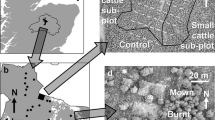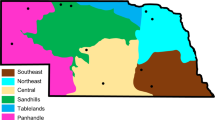Abstract
Recreational use of wilderness results in impacts to vegetation and soil in trails and campsites. Traditionally, campsite impact studies have compared campsites receiving various levels of use with unused control areas. Field studies in Sequoia National Park, California, indicate that the degree of impact to vegetation and soils also varies within campsites. The central areas of campsites, where trampling is concentrated, show lower plant species diversity, differences in relative species cover, more highly compacted soils, and lower soil nutrient concentrations than do peripheral, moderately trampled, and untrampled areas within the same campsite. Three years after closure to visitor use, the central areas show less increase in mean foliar plant cover, and soils remain more highly compacted than in previously moderately trampled areas of the same sites. Changes in relative species cover over time are used to assess both resiliency to trampling and species composition recovery within campsites closed to visitor use.
Similar content being viewed by others
Literature cited
Blake, G. R. 1965. Bulk density. Pages 374–380in C. A. Black (ed.), Methods of soil analysis, part 1. American Society of Agronomists, Inc., Madison, Wisconsin.
Bouyoucos, G. J. 1926. Estimation of the colloidal material in soils.Science 64:362.
Bratton, H., W. G. McCully, U. M. Taylor, and J. E. Box, Jr. 1966. Influence of soil compaction on emergence and first-year growth of seeded grasses.Journal of Range Management 19:118–121.
Bratton, S. P., M. G. Hickler, and J. H. Graves. 1978. Visitor impact on backcountry campsites in Great Smoky Mountains.Environmental Management 2:431–442.
Cole, D. N. 1977. Man's impact on wilderness vegetation: an example from Eagle Cap Wilderness, northeastern Oregon. PhD dissertation, University of Oregon, Eugene, Oregon, 307 pp.
Cole, D. N. 1978. Estimating the susceptibility of wildland vegetation to trailside alteration.Journal of Applied Ecology 15:281–286.
Cole, D. N. 1982. Wilderness campsite impacts: effects of amount of use. USDI Forest Service Research Report INT-RP-284-FR30, 34 pp.
Cole, D. N. 1983. Monitoring the conditions of wilderness campsites. USDA Forest Service Research Paper INT-302. Ogden, Utah, 10 pp.
Cole, D. N., and J. Dalle-Molle, 1982. Managing campfire impacts in the backcountry. USDA Forest Service General Technical Report INT-135. Ogden, Utah, 16 pp.
Dale, D., and T. Weaver. 1974. Trampling effects on vegetation of the trail corridors of north Rocky Mountain forests.Journal of Applied Ecology 11:767–772.
Dawson, J. O., D. W. Countryman, and R. R. Fittin. 1978. Soil and vegetation patterns in northeastern Iowa camp-grounds.Journal of Soil and Water Conservation 33:39–41.
Dotzenko, A. D., N. T. Papamichos, and D. S. Ramine. 1967. Effect of recreation use on soil and moisture conditions in Rocky Mountain National Park.Journal of Soil and Water Conservation 22:196–197.
Dykema, J. A. 1971. Ecological impact of camping upon the southern Sierra Nevada. PhD dissertation, University of California, Los Angeles, California, 156 pp.
Easterbrook, A. L. 1968. The effects of soil compaction on the occurrence of vegetatively reproducing plants in campsites. Master's Thesis, University of Michigan, Ann Arbor, Michigan, 97 pp.
Fichtler, R. K. 1980. The relationship of recreational impacts on backcountry campsites to selected Montana habitat types. Master's Thesis, University of Montana, Missoula, Montana, 109 pp.
Frissell, S. S., Jr., and D. P. Duncan. 1965. Campsite preference and deterioration in the Quetico-Superior canoe country.Journal of Forestry 63:256–260.
Frissell, S. S., and G. H. Stankey. 1972. Wilderness environmental quality: search for social and ecological harmony. Pages 170–183in Proceedings, Society of American Foresters annual meeting. Hot Springs, Arkansas.
Hartley, E. A. 1976. Man's effects on the stability of alpine and subalpine vegetation in Glacier National Park, Montana. PhD dissertation, Duke University, Durham, North Carolina, 258 pp.
Holmes, D. O., and H. E. M. Dobson. 1976. Ecological carrying capacity research: Yosemite National Park: Part I. US Department of Commerce, National Technical Information Service, no. PB270-955, 247 pp.
Isaac, R. A., and W. C. Johnson. 1976. Determination of total nitrogen in plant tissue, using a block digestor.Journal of the AOAC 59:98–100.
LaPage. 1967. Some observation on campground trampling and ground cover response. USDA Forest Service Research Paper NE-68. Northern Forest and Range Experiment Station, Upper Darby, Pennsylvania, 11 pp.
Minore, D., C. E. Smith, R. F. Woollard. 1969. Effects of high soil density on seedling root growth of seven northwestern tree species. USDA Forest Service Research Note PNW-112. Portland, Oregon, 6 pp.
Monti, P., and E. E. Mackintosh. 1979. Effect of camping on surface soil properties in the boreal forest region of north-western Ontario.Soil Science Society of America Journal 43:1024–1029.
Palmer, R. 1972. Human foot impact: a preliminary report of the effects of human traffic on two alpine meadows in the Sierra Nevada. Page 15–25in H. T. Harvey, R. H. Hartesvedt, and J. T. Stanley (eds.), Wilderness impact study report. Sierra Club Outings Committee, San Francisco.
Parsons, D. J., and S. A. MacLeod. 1980. Measuring impacts of wilderness use.Parks 5:8–12.
Perkin-Elmer Company. 1976. Analytical methods for atomic absorption spectrophotometry. Norwalk, Connecticut. Revised September 1976.
Peters, D. B. 1965. Water availability. Pages 279–285in C. A. Black (ed.), Methods of soil analysis, part I. American Society of Agronomists, Inc., Madison, Wisconsin.
Ranz, B. 1979. Closing wilderness campsites: visitor use problems and ecological recovery in the Selway-Bitterroot Wilderness, Montana. Master's Thesis, University of Montana, Missoula, Montana, 125 pp.
Rundel, P. W., D. J. Parsons, and D. T. Gordon. 1977. Montane and subalpine vegetation of the Sierra Nevada and Cascade Ranges. Pages 559–599in M. Barbour and J. Major (eds.), Terrestrial vegetation of California. John Wiley and Sons, New York.
Rutherford, G. K., and D. C. Scott. 1979. The impact of recreational land use on soil chemistry in a provincial park.Park News 15:22–25.
Schuman, G. E., M. A. Stanley, and D. Knudsen. 1973. Automated total nitrogen analysis of soil and plant samples.Soil Science Society of America, Proceedings 37:480–481.
Settergren, C. D., and D. M. Cole. 1970. Recreation effects on soil and vegetation in the Missouri Ozarks.Journal of Forestry 68:231–233.
Simon, L. 1978. Soil physical properties of selected campsites under varying use levels in the Kearsarge-Bullfrog-Charlotte Lakes area of Kings Canyon National Park. Unpublished report. Sequoia and Kings Canyon National Parks, California, 54 pp.
Stohlgren, T. J. 1982. Vegetation and soil recovery of subalpine campsites in Sequoia National Park, California. Master's Thesis, California State University, Fresno, California, 49 pp.
Young, R. A., and A. R. Gilmore. 1976. Effects of various camping intensities on soil properties in Illinois campgrounds.Soil Science Society of America Journal 40:908–911.
Author information
Authors and Affiliations
Rights and permissions
About this article
Cite this article
Stohlgren, T.J., Parsons, D.J. Vegetation and soil recovery in wilderness campsites closed to visitor use. Environmental Management 10, 375–380 (1986). https://doi.org/10.1007/BF01867262
Issue Date:
DOI: https://doi.org/10.1007/BF01867262




